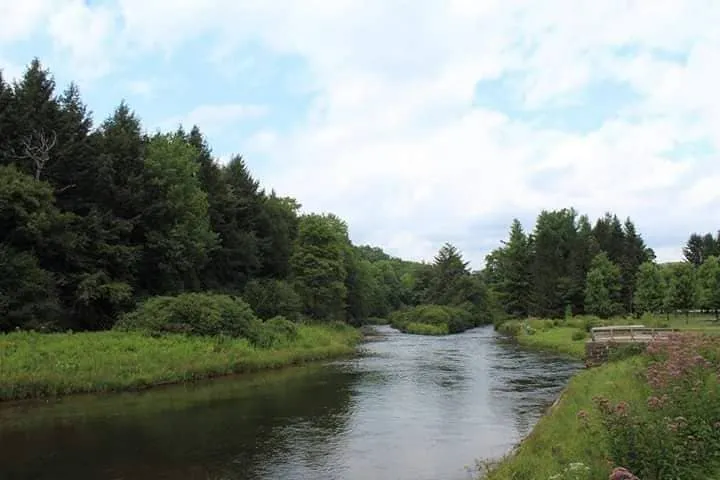The developed area of the Bendigo State Park is approximately 20 acres, half of which is a large shaded picnic area. Bendigo State Park is located 4 miles northeast of Johnsonburg on Legislative Route 24201, which branches off U.S. Route 219 in Johnsonburg. This beautiful stream, once polluted by mine acid drainage, is now stocked with trout by the Pennsylvania Fish Commission providing excellent fishing. The vegetation of the area is predominantly of the northern hardwood type which is composed of beech, birch, cherry and maple.
Opportunities
Swimming: The 35 x 105 foot pool in the park receives very heavy use during the summer season. Depth ranges from 3 to 5 feet
Picnicking: Over 150 picnic tables are scattered in several locations of the park. Supporting facilities include fireplaces, drinking water, two horseshoe pits and comfort stations.
Sledding and Tobogganing: A designated slope is used by many visitors who come to ride sleds or to play in the snow. Winter picnics after a day of sledding are popular.
History of the Park
Bendigo State Park was named after the former town of Bendigo settled by Alfred Truman in 1895. The town was named by the Pennsylvania Railroad after a famous English boxer, William Thompson (1811-1880). Thompson's fighting name, Bendigo, is a corruption of the Old Testament name Abendnego of Shadrach, Meshach and Abendnego. Bendigo's fighting career (1832-1851) was near perfect with only one loss. As ring fights were illegal, Bendigo was arrested 28 times for violating the anti-fight law. His religious activities were encouraged by prison chaplains and Bendigo became a noted Methodist evangelist after his boxing career. A monument to him was dedicated in Nottingham in 1891.
Mr. Truman established a sawmill on the site where the park now stands. Even today parts of old logs and decayed bark may be uncovered during excavation work. The former Johnsonburg and Clermont Railroad chartered in 1887, once ran through the park area and served all the large sawmills in the area. Besides the Truman sawmill, B.F. Hazleton built a large sawmill at Glen Hazel. Railroad stations were in towns such as Glen Hazel, Instanter and Clermont. The rail service was discontinued in the 1930s, and the old railroad bed can still be seen in the park. In fact, the main parking lot road is the old railroad bed.
The park began as a community project by the town of Johnsonburg during the 1920s. The Works Progress Administration (WPA) in the 1930s made many improvements. The stone wall and dam on the East Branch of the Clarion River were built by the WPA.The park is located in a small valley surrounded with many picturesque hills.
In August 1948, proceedings were initiated to deed the parcel of land on which the park now stands to the Commonwealth of Pennsylvania. In April 1949, the late Senator George B. Stevenson introduced a bill before the State Senate which permitted the Commonwealth of Pennsylvania to acquire the park.
In 1958, the Secretary of the former Department of Forests and Waters recommended improvements for the park. In response, the legislature appropriated funds and instructed the General State Authority to make improvements to park facilities and the existing dam.
Facilities, including the swimming pool, continued to be improved and built and on August 15, 1959, Bendigo State Park was formally dedicated by Maurice K. Goddard, then Secretary of the Department of Forests and Waters.
New Flanders was a settlement of Belgian glass blowers under the leadership of Count De Hamm. This settlement lasted only a few years before the people learned they could not make a living with their occupation. New Flanders next became a thriving logging and lumbering community by the name of Glen Hazel and contained many restaurants, hotels and stores.
Return to
